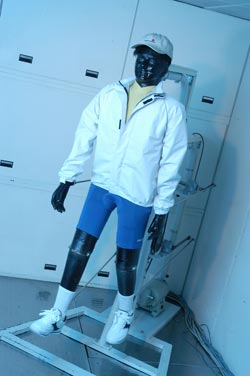Hohenstein researchers improve functional sportswear

One of the ways of assessing the comfort characteristics of sportswear and other textiles at the Hohenstein Institute is by using the thermo-regulatory articulated manikin Charlie.<br>
German manufacturers of sports textiles are among the most innovative companies in the textile industry. Researchers at the Hohenstein Institute in Bönnigheim are helping these companies to improve the functional properties of their textiles by developing practical construction guidelines.
In a recently completed research project: (AiF No. 15481 N), with funding from the Federal Ministry of Economics and Technology (BMWi) provided through the Federation of Industrial Research Associations (AIF), they drew specific conclusions about the physiological comfort characteristics of a variety of different types of knitted garments. The textile industry will be able to use the construction guidelines that resulted from the research work to continue developing and optimising functional clothing for all kinds of different sports.
The research project entailed investigating a total of 34 assorted knitted fabrics in respect of their thermo-physiological characteristics. These samples varied in terms of their fibres (PES, PP, PA, WO and CO and some mixed fibres), weight per unit area (100 to 329g), surface finish (hydrophilic, bioactive) and knit structure(e.g. single-jersey or pique). Specially selected representative samples were tested in controlled trials involving volunteers wearing them in a climate-controlled room. The skin model was used to measure thermo-physiological properties, i.e. how heat and moisture are transported through the textile. When this data was combined with the results of skin sensory testing, it was possible to work out a comfort rating for each sample. The textiles were assessed along the lines of the German school marks system, from 1 = “very good” to 6 = “unsatisfactory”.
On average, all the knitted sports textiles that were investigated received marks that were satisfactory or better for sports textile comfort (TK(S)). Nine samples were awarded marks of 1.0 to 1.5 (= “very good”). Chemical fibres were at a distinct advantage when it came to transporting liquid perspiration and the way they dried. On the other hand, the natural fibre samples made of wool and cotton had the edge when it came to retaining perspiration. Comparing pairs of samples of textiles where the main fibre was polyamide, but with and without a hydrophilic finish, showed that the hydrophilic finish had a negative effect on the level of comfort, because the fabric took longer to dry. However, applying a hydrophilic finish to samples made of propylene or a mixture of cotton and polypropylene gave a better result for comfort because they did not stick to the skin so much.
Contact:
Hohenstein Institute
Martin Harnisch
m.harnisch@hohenstein.de
We are grateful to the Research Association of the Textile Research Council for its financial support for IGF project no. 15481 N, which was provided using funds from the Federal Ministry of Economics and Technology (BMWi) via the Federation of Industrial Research Associations AIF as part of the programme to support “Industrial Community Research and Development” (IGF).
We must also thank all members of the project support committee who, with their specialist expertise and willingness to contribute to the discussions, helped ensure a successful conclusion to the project.
Media Contact
All latest news from the category: Materials Sciences
Materials management deals with the research, development, manufacturing and processing of raw and industrial materials. Key aspects here are biological and medical issues, which play an increasingly important role in this field.
innovations-report offers in-depth articles related to the development and application of materials and the structure and properties of new materials.
Newest articles

Retinoblastoma: Eye-Catching Investigation into Retinal Tumor Cells
A research team from the Medical Faculty of the University of Duisburg-Essen and the University Hospital Essen has developed a new cell culture model that can be used to better…

A Job Well Done: How Hiroshima’s Groundwater Strategy Helped Manage Floods
Groundwater and multilevel cooperation in recovery efforts mitigated water crisis after flooding. Converting Disasters into Opportunities Society is often vulnerable to disasters, but how humans manage during and after can…

Shaping the Future: DNA Nanorobots That Can Modify Synthetic Cells
Scientists at the University of Stuttgart have succeeded in controlling the structure and function of biological membranes with the help of “DNA origami”. The system they developed may facilitate the…



